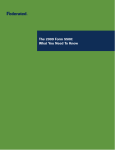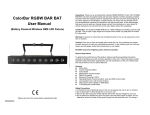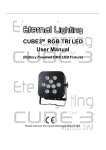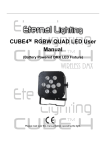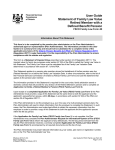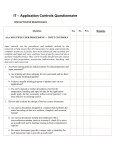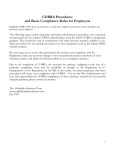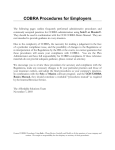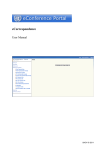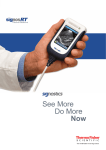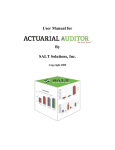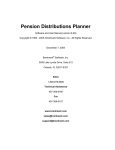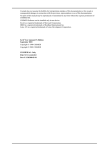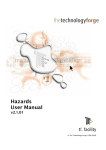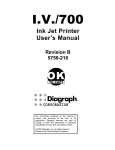Download 5500 - US ELF: EFAST2 FAQs
Transcript
EFAST2 All-Electronic Filing System U.S. Department of Labor Employee Benefits Security Administration March 2010 General Q1: I heard that I will have to start filing the annual return/report (Form 5500 or Form 5500-SF) electronically. Can you tell me if that’s true and when I would need to start? All pension and welfare plans and DFEs that are required to submit an annual return/report under Title I of ERISA (Form 5500 or Form 5500-SF) must do so electronically for plan years beginning on or after January 1, 2009. Beginning January 2010, an all-electronic system called EFAST2 will receive those electronic annual returns/reports. Once the EFAST2 electronic system is online and ready to receive filings, you must file the Form 5500 or Form 5500-SF electronically through EFAST2 for plan/reporting year 2009 and for subsequent plan/reporting years. Prior year delinquent or amended Form 5500 annual return/reports generally must be filed electronically through EFAST2. See question 4. The Form 5500-EZ cannot be submitted electronically. A “one-participant” plan (see the instructions for the Form 5500-SF) that is eligible to file Form 5500-EZ and is not required to file under Title I of ERISA may elect to file Form 5500-SF electronically with EFAST2 rather than filing a Form 5500-EZ on paper with the IRS. Such a “one-participant plan” that is not eligible to file Form 5500-SF must file Form 5500-EZ on paper with the IRS. For more information on filing the Form 5500-EZ, see the instructions for Form 5500-EZ, go to www.irs.gov, or call 1-877-829-5500. Q2: How can I file my timely plan year 2008 annual return/report if it is due after January 1, 2010? You have several options: A. You can electronically file a plan year 2008 annual return/report using EFAST2-approved thirdparty software or IFILE beginning January 2010. EFAST2 is the new filing system. B. You can electronically file a plan year 2008 annual return/report using EFAST-approved thirdparty software until June 30, 2010. EFAST is the current filing system. C. You can file a plan year 2008 annual return/report on paper through the current EFAST filing system, using EFAST-approved software or government-issued hand print forms, until October 15, 2010. Q3: Short plan year 2009 annual returns/reports (Form 5500 or Form 5500-SF) may be due before EFAST2 can receive them in January 2010. How do I file these? Short 2009 plan year filers whose due date to submit their 2009 filing is before January 1, 2010 will be given an automatic extension to electronically file their complete Form 5500 annual return/report within 90 days after the 2009 filing system is available on the DOL Web site. This special extension is being granted to encourage such filers to submit their 2009 returns/reports electronically under EFAST2. Filers who choose not to take advantage of the special extension must use plan year 2008 forms and instructions and submit their annual return/report on or before the due date for their filing under the current EFAST system (before EFAST2 and the 2009 Forms and instructions are available for filing in January 2010). Q4: How can I submit a delinquent or amended Form 5500 return/report for a Title I plan for years prior to 2009 once the EFAST2 system is available? Beginning January 1, 2010, delinquent and amended filings of Title I plans must be submitted electronically through EFAST2 and cannot be submitted on paper through the current EFAST system. A limited exception is available, however, for delinquent and amended 2008 plan year filings. Specifically, while you may submit a delinquent or amended 2008 plan year filing electronically through EFAST2 beginning January 1, 2010, you also have the option to submit it through EFAST either on paper until October 15, 2010 or electronically until June 30, 2010. After October 15, 2010, even 2008 plan year filings of Title I plans must be submitted electronically through EFAST2. To submit a delinquent or amended Form 5500 return/report electronically through EFAST2 for plan years prior to 2009, you must submit the filing using current filing year Form 5500, schedules, and instructions except as provided below. The current filing year forms take the place of the Form 5500 pages that would have been included in the prior year's filings. The electronic filing on the current filing year Form 5500, however, must indicate, in the appropriate space at the beginning of the Form 5500, the plan year for which the annual return/report is being filed. Exceptions to requirement to use current filing year schedules and instructions: Filers using EFAST2 must use the following correct-year schedules (that is, the plan year for which the annual return/report relates) completed in accordance with the related correct-year instructions: x x x x x Schedule B, SB, or MB (Actuarial Information), Schedule E (ESOP Annual Information), Schedule P (Annual Return of Fiduciary of Employee Benefit Trust), Schedule R (Retirement Plan Information), and Schedule T (Qualified Pension Plan Coverage Information). For example, if you are filing a delinquent 2007 Form 5500 return/report for a defined benefit pension plan, you must include the 2007 Schedule B, Schedule R and all required attachments for these schedules. Attach them as pdf images to the current filing year Form 5500 (2009 or 2010 forms can be used as current filing year forms as of 1/1/2010), tagging them as "other attachments." Also, you have the option of using either the current filing year or the correct-year (2007 in this example) Schedule C. Since the Schedule E would not apply to a defined benefit plan, and the Schedule P and Schedule T did not apply for 2007 plan year filings, all other required schedules and attachments should be completed using current filing year forms and instructions. The entire filing should then be filed electronically in accordance with EFAST2 electronic filing requirements. To obtain correct-year schedules and related instructions, go to www.dol.gov/ebsa/5500main.html and print the schedules and instructions of the form year that corresponds to the plan year for which you are filing. IMPORTANT: Do not attach any Schedule SSA to any filing with EFAST2. Rather, submit the most current year Form 8955-SSA to the IRS (along with all required attachments). See www.irs.gov/ep for additional information. IMPORTANT: Do not send any penalty payments associated with a delinquent filing to EFAST2. Penalty payments to the IRS or made under the Department's Delinquent Filer Voluntary Compliance (DFVC) Program must be submitted separately in accordance with the applicable requirement. Q4a: Can filers use the Form 5500-SF to file 2008 or prior year delinquent or amended return/reports? No. You may not file the Form 5500-SF for any 2008 or prior plan year return/report. Filers wishing to file or amend their plan year 2008 or prior Form 5500 must use the current Form 5500 to submit that return/report in accordance with the directions in question 4. Required schedules must be included in accordance with the procedures described in question 4. Filers wishing to file or amend their plan year 2008 or prior Form 5500-EZ must use the correct prior year paper version only and must file it with the IRS. Filing electronically using EFAST2 on a Form 5500 or Form 5500-SF is not allowed. Filers should contact the IRS at 1-877-829-5500 for further information. Filing Preparation Software Q5: What is IFILE? IFILE is the Form 5500 and Form 5500-SF annual return/report preparation and submission application that will be on DOL’s Web site www.efast.dol.gov. Q6: Do I have to use IFILE? No. IFILE is offered as an alternative to EFAST2-approved third-party software. Q7: How do I know what third-party software is approved? A list of EFAST2-approved third-party software will be posted on www.efast.dol.gov. There will be two types of software certification in EFAST2: certification for software to prepare filings and certification for software to submit filings. Make sure the software you are using is approved for the function(s) you will need to have performed by the software (i.e., filing preparation and/or submission). Q8: What are the benefits of using EFAST2-approved third-party software instead of IFILE? Historically, 90 percent of filers have used approved third-party software. Continuing to use approved third-party software will provide you with continuity in the switch to the new system, which should help minimize the possibility of technical issues. IFILE cannot be used to transmit batches of filings; it can only be used to transmit single filings. Many third-party preparers benefit from transmitting batches of filings. Some EFAST2-approved third-party software may support transmission of batches of filings. IFILE does not help you prepare an annual return/report. Some EFAST2-approved third-party software may integrate with your systems to automatically populate some of the information required. IFILE does not contain filing assistance or integrated instructions. Some EFAST2-approved third-party software may provide such value-added support. IFILE does not allow more than one individual to edit a filing without exporting, downloading, importing, etc. (see questions 20 and 30); whereas, some EFAST2-approved third-party software may provide such file sharing functionality. With file sharing as part of the software, different people can work on a single filing in a coordinated and streamlined manner. Q9: I currently use EFAST-approved software to prepare my Form 5500 and then print and mail the annual return/report to EFAST. What will I need to do differently for my plan year 2009 annual return/report? You may be able to use the same type of third-party software that you have been using to prepare your Form 5500, but you need to ensure that the version you use is approved for the 2009 plan year by EFAST2. A list of EFAST2-approved third-party software will be posted on www.efast.dol.gov. Instead of printing and mailing the annual return/report to EFAST, the plan administrator must electronically sign it and then the electronically signed annual return/report must be submitted over the Internet to EFAST2. Your EFAST2-approved third-party software will transmit the filing to the EFAST2 system and subsequently provide you with your filing status. Registering for EFAST2 Credentials Q10: When can I register for EFAST2 electronic credentials to sign a Form 5500 or Form 5500-SF? Once EFAST2 is operational in January 2010 you can begin registering for electronic credentials through the EFAST2 Web site www.efast.dol.gov. Q11: When I register for electronic credentials through the EFAST2 Web site, what are the different user types and what type(s) of user should I select? There are five user types under EFAST2. You can check as many as apply to you. You may associate more than one user type under your registration if you will be performing multiple functions: Filing Author: Filing Authors can complete Form 5500/5500-SF and the accompanying schedules, submit the filing, and check filing status. Filing Authors cannot sign filings unless they also have the “Filing Signer” role. If you are using EFAST2-approved third-party software to author your filing rather than IFILE, you do not need to check this box. Filing Signer: Filing Signers can sign Form 5500/5500-SF filings. Signers must ensure that the filing information is correct prior to its submission. The signer’s signature indicates that to the best of the signer's knowledge and belief the filing is true, correct, and complete. Signers include Plan Administrators, Employers/Plan Sponsors, and Direct Filing Entities. No other filing-related work may be done by the Filing Signer if this is the only user type selected. Further, for purposes of Title I of ERISA, the plan administrator (either as the Filing Signer or, if a non-individual entity, on whose behalf an individual authorized to sign on behalf of the plan administrator has signed as a Filing Signer) remains legally responsible for the timeliness of the submission of the Form 5500/5500-SF by a Transmitter. Schedule Author: Schedule Authors can complete one or more of the schedules that accompany Form 5500/5500-SF. Schedules created by a Schedule Author are not associated with a filing. For a schedule created by a Schedule Author to be used in a filing, the schedule must be exported. This exported file will then be imported by the Filing Author to the correct filing. Schedule Authors cannot initiate, sign, or submit a filing. If the Filing Author is using EFAST2-approved third-party software to author your filing rather than IFILE, then you do not need to check this box. Transmitter: Transmitters can transmit Form 5500/5500-SF filings to the EFAST2 system for processing on behalf of others. Transmitters are responsible for the security of all filing information prior to and during its transmission. A Transmitter can be a company, trade, business, or individual. Third-Party Software Developer: Third-Party Software Developers make Form 5500 filing preparation or transmission software for use in the EFAST2 system. They submit test cases using their software to the Participant Acceptance Testing System (PATS) Team. The PATS Certification Team will then review their submissions and provide feedback or approve and certify the software. A ThirdParty Software Developer can be a company, trade, business, or individual. Q12: If I am completing a Form 5500 or Form 5500-SF using an EFAST2-approved thirdparty software program, will I need to register for EFAST2 electronic credentials? You do not need to register for EFAST2 electronic credentials just to complete the annual return/report using third-party software. If you will be submitting the filing to EFAST2, however, you will need to register for credentials as a “Transmitter” user type. If you will be signing the filing, you will need to register for credentials as the “Filing Signer” user type. Q13: When registering for EFAST2 credentials, what’s the difference between a Filing Author and a Transmitter? A Filing Author is the person who initiates (including filling out) the Form 5500 or Form 5500-SF and the schedules and attachments on IFILE. A Transmitter is the person or organization who actually submits the completed annual return/report to EFAST2. Q14: What do I need to do to serve as a third-party software provider under EFAST2? You will need to get Third-Party Software Developer credentials (see question 11). There are two separate credentials for third-party software: 1. for filing preparation software; and 2. for filing transmission software. If you are developing software that will be used to prepare annual return/report filings, you will need to seek certification for filing preparation software. The certification for filing preparation software checks that the XML files designed to populate the annual return/report and schedules are correctly assembled and formatted. If you are developing software that will be used to transmit filings, you will need to seek certification for filing transmission software. The certification for filing transmission software checks that the web requests using the third-party software can be correctly sent by transmitters to EFAST2 and received from EFAST2 by the transmitter. Initial third-party software developer specifications have been provided to prospective developers. If you have not received these and are interested in being an EFAST2-approved third-party software developer, please call 1-866-GO-EFAST. Q15: I already have a PIN and ID for electronic filing in EFAST. Can I use that for submitting my filing electronically in EFAST2? No. EFAST2 is a completely separate system from EFAST. You will need to register for and obtain new electronic credentials under EFAST2. Q16: How can I update my email address or other contact information after I’ve registered? After successfully logging into the EFAST2 Web site, click on the “Profile” link in the navigation bar and you will be able to change any of your contact information, including email address. Q16a: I completed the registration online but did not receive an email to complete my registration. What should I do? Once you complete the online registration, the system sends an email to your registered email address within 5 minutes. If you did not receive the email in your inbox, it may have been blocked as spam or junk mail. Check your “spam” or “junk” email folders to see if you have received the email. If you’ve checked your “spam” or “junk” email folders and the email has not been received, call 1-866-463-3278 (1-866-GO-EFAST). Some email providers require that you add an email address to your address book before you can receive any email from that address. To ensure that our messages can be delivered to your inbox, enter our originating email address, [email protected] and our reply to email address, [email protected] into your address book. Completing an Annual Return/Report (Form 5500 or Form 5500-SF) Q17: I am filing a Form 5500-SF for a plan covered by Title I of ERISA and the plan invested in a direct filing entity. I don’t see a way to complete a Schedule D for a Form 5500-SF. Do I have to attach a Schedule D? The only schedules required to be filed with the Form 5500-SF for a plan that is covered by Title I are the Schedule SB (actuarial information) for defined benefit pension plans or Schedule MB (actuarial information) for money purchase plans that are amortizing funding waivers. No other schedule should be submitted with the Form 5500-SF. If you are filing the Form 5500, you must submit all required schedules and attachments, including the Schedule D, if applicable. Q18: I don’t see a way to complete a Schedule SSA in EFAST2. How do I file my SSA information with the Government? Beginning with the 2009 plan year, the Form 5500 series does not include the Schedule SSA. Do not find a prior year Schedule SSA, fill it out and attach that to your 2009 Form 5500 filing! Do not try to create your own Schedule SSA and attach that to your Form 5500 filing! SSA information will be collected by the IRS. If you include a social security number on your annual return/report (such as appears on the old Schedule SSA) or in any of the attachments (including PDFs or other forms of attachments), your filing may be rejected. Because your filing, including any attachments, will be posted on the Internet, it must not contain any Schedule SSA information or social security numbers. For more information on the form that replaces the Schedule SSA, please contact the IRS (www.irs.gov). Q19: How can I see what my annual return/report will look like before it is filed? Using your filing preparation software, you can view your annual return/report as it would appear populated in a form facsimile. In IFILE, you can click the “View as PDF” button to see your annual return/report in a facsimile format. If you are using EFAST2-approved third-party software, check your user manual for instructions on how to view your annual return/report in a facsimile format. Q20: Can I show my annual return/report to other people for review before I submit it to the Government? If you have a draft annual return/report (Form 5500 or Form 5500-SF) that you wish for other people to review, you can export the draft annual return/report. When you do that, you will have an XML file that you can send to other individuals. Those individuals can import the XML file into their EFAST2approved third-party software or into IFILE to review. If they wish to make changes to the draft annual return/report, they can do so, but they need to export the revised annual return/report into an XML file and send that back to you for the changes to be included in the transmission to EFAST2. Q21: Is there a way I can check to see if there are errors in my filing before I submit it? Yes. You can (and should) “validate” your filing before submitting it. The automatic validation will perform an initial check for errors, such as if Schedule H numbers are not consistent within Schedule H or with the Form 5500. This is a check of errors in your filing before you submit it to the Government. If the errors/warnings are not corrected before submission, the Government will be alerted to the errors associated with your filing when it is submitted. Please run the pre-validation check and correct any errors/warnings to the best of your ability before you submit your filing. After a filing is submitted to EFAST2, the Government may perform additional checks of the annual return/report, and your filing may be rejected based on these additional checks. Q22: Can a draft Form 5500 be "submitted" for viewing online and reviewing? Please do not submit a draft annual return/report to EFAST2. When you "submit” an annual return/report, you are sending it to the Government. Do not submit a draft annual return/report to EFAST2 simply because you or your client wish to see what the filing will look like after it is filed. If you wish to view a completed annual return/report in IFILE, see the IFILE Users’ Guide. Also, see questions 20 and 21 for additional information on reviewing and checking your file before submission. Q23: If the answer to a question seeking an amount is none, or zero, should I fill the numeric fields with zero or leave it blank? If the numeric answer to the question is zero, or if the question provides that you cannot leave it blank, then enter “0“. Only leave a numeric field blank where the instructions specifically permit you to do so. If you leave an item blank that should be zero and then validate your annual return/report for errors, you will be notified that the item must be completed. Conversely, if you enter zero in an item that should have been blank and then validate your annual return/report for errors, you may receive different error messages. Consult the Form 5500 or 5500-SF instructions for guidance specific to each question on the forms. Attachments Q24: How do I attach the report of the independent qualified public accountant (IQPA report)? The IQPA report needs to be documented on letterhead, signed, and then saved as a single Portable Document Format (PDF) file. That PDF file then needs to be attached to the Form 5500 annual return/report. When you submit the Form 5500 annual return/report, the attachments will be transmitted to EFAST2 along with the rest of the information in the annual return/report. Q25: Will the EFAST2 system still receive my filing if I do not attach the IQPA report with my Form 5500 annual return/report when it is required? The EFAST2 system will receive your filing, but submitting the annual return/report without the required IQPA report is an incomplete filing, and the incomplete filing may be subject to further review, correspondence, rejection, and assessment of civil penalties. Also, if you do not submit the required IQPA report, you must still correctly answer the IQPA questions on Schedule H, line 3. This means you must leave lines 3a and 3b blank because the IQPA report is not attached and must also leave line 3d blank because the reason the IQPA reports is not attached (i.e., was not completed on time) is not a reason listed in any of the available check boxes. You should still complete line 3c if you can identify the plan’s IQPA. Please note that failing to include the required IQPA report and leaving parts of line 3 blank, however, will result in the system status indicating that there is an error with your filing because, as noted above, submitting your annual return/report without a required IQPA report is an incomplete filing, and the incomplete filing may be subject to further review, correspondence, rejection, and assessment of civil penalties. Thus, if you find it necessary to file a Form 5500 without the required IQPA report, you must correct that error as soon as possible. Q26: If I am filing for an extension of time based on a request for an extension submitted on Form 5558 with the Internal Revenue Service, do I need to attach a copy of the Form 5558 to my Form 5500 or Form 5500-SF? You do not need to attach a copy of the Form 5558 that was filed with the Internal Revenue Service to the annual return/report in EFAST2. You must, however, keep a copy of the Form 5558 that was filed with the Internal Revenue Service with the plan’s records. Q27: What file format do I need to use for attachments to my filing to make sure they get transmitted to and received by EFAST2? The IQPA report, image of the signed Schedule MB, and image of the signed Schedule SB must be submitted in Portable Document Format (PDF). All other attachments can be submitted in either PDF or plain text format (TXT). Q28: How do I turn an attachment into a PDF file? Using software that will create a PDF file from another software application’s data file often provides the best quality PDF and small file size. There are many software options for creating PDFs by “saving as” a PDF file or “printing” to a PDF file rather than a printer. When you are creating a PDF file using such software, you often must have the application that created the original file installed on your computer. You can also create a PDF file by using other free and paid software programs that you may already be using on your personal computer, regardless of your operating system. Q29: Can I turn a paper document into a PDF file? Scanners generally come with software that includes an option to save a scanned document as a PDF. Look for menu items such as “output type” or “settings” to select PDF as the output file type. Consult your scanner’s user manual for specific instructions. When creating a PDF file by scanning a paper document, you need to be careful that the resulting file size is not too large. There is a limitation on the size of submissions sent to EFAST2. Scanning your document at 300x300 resolution and using True Gray, Grayscale, or Black and White color depth can help to minimize the resulting file size of the PDF. If you are scanning multiple pages and your scanner does not have a document feeder, you will need to scan each page and then combine them into one PDF file for each attachment type. Check that your pages appear in the order you want them prior to saving and submitting them. You are encouraged to use software that will create a PDF from another application’s data file, as this often produces a better quality PDF file and small file size, as described in the previous question. Signing a Return/Report Q30: If I am using EFAST2-approved third-party software to prepare a filing for a client, how do I provide the plan sponsor/administrator signature (PIN) in the submission? There are a few alternatives: A. Your EFAST2-approved third-party software may have a file sharing function (see question 8) that allows a plan sponsor to view and apply their signature to the filing. Check with your software vendor or user’s manual to see if the software vendor offers this function. B. You can use IFILE as a medium to share the filing with the plan administrator/plan sponsor. How you do that depends on whether you want to submit the filing or whether the plan administrator/plan sponsor wants to submit the filing. It also depends on whether the plan administrator/plan sponsor wants the ability to make changes to the annual return/report before submission. The person who will submit the filing needs to import it into IFILE as explained below. 1. If you expect to submit the filing, you would need to export the annual return/report from your EFAST2-approved third-party software to an XML file. You can import the XML file into IFILE. After the file is imported into IFILE, you would need to specify the plan administrator/plan sponsor as the signer by entering the plan administrator/plan sponsor’s email address. If the plan administrator/plan sponsor had not yet registered in EFAST2 as a Filing Signer, you will be alerted at this time. The plan administrator/plan sponsor would log in to IFILE using their EFAST2 electronic credentials. The plan administrator/plan sponsor would not be able to edit the filing but would be able to view and sign the filing. Once the filing is signed, you could then submit it. The Filing Signer, however, retains legal responsibility for the timeliness of the submission, as well as for its accuracy and completeness. 2. If the plan administrator/plan sponsor wants to submit the filing, you would need to export the annual return/report from your EFAST2-approved third-party software to get an XML file that you would send to the plan administrator/plan sponsor. The plan administrator/plan sponsor would need to have already registered in EFAST2 as a Filing Author and as a Filing Signer. The plan administrator/plan sponsor can log in to IFILE and import the XML file generated by the third-party software into IFILE. The plan administrator/plan sponsor can then review and edit the annual return/report in IFILE. Then the plan administrator/plan sponsor would identify himself when registering as the Filing Signer. Once the plan administrator/plan sponsor signs the filing, he or she could then submit it. If an annual return/report is signed and then exported or edited, the signatures are erased. If you export or edit it after it was signed, the plan sponsor or plan administrator will need to sign it again before the annual return/report is submitted. This applies whether you are using IFILE or EFAST2-approved third-party software. Q31: Do you need a separate registration for the “Employer/Plan Sponsor” and for the “Plan Administrator” (two separate signature lines) if the employer/plan sponsor and the plan administrator are the same person? No, you only need to register one time for both purposes. The credentials that you get can be used for multiple years and on multiple filings. If the same person serves as both the plan sponsor and plan administrator, that person only needs to sign as the plan administrator on the “Plan Administrator” line. Q32: I am a third-party preparer that represents small businesses that do not have their own computers. Can I register for Filing Signer credentials on their behalf? No. The EFAST2 process for obtaining Filing Signer credentials is designed so that the person signing electronically must be the person registering for the credentials. Access to any computer with an Internet connection is all that is required to register. Thus, your client may come to your office, use a personal computer at home, or go to a public library or copying center with a computer, and register for credentials using free email accounts or an email account provided by your company (e.g., tpafirm.com). Q33: I am a plan administrator that needs to electronically sign a Form 5500. Can I tell my preparer what my PIN is so they can sign and submit it for me? As the plan administrator, the Form 5500 or 5500-SF that will be sent to EFAST2 must be examined by you before it is submitted. Your signature attests that has been done and that, to the best of your knowledge and belief, it is true, correct, and complete. Since the EFAST2 PIN is the plan administrator/sponsor/DFE's electronic signature for purposes of the Form 5500 and Form 5500-SF, PINs must be protected and not shared. We appreciate the fact that some filers may find it easier to comply with the electronic signature requirement if PIN sharing were permitted. However, we believe plan administrators and other filers will be able to comply with their annual reporting obligations within the EFAST2 system PIN requirements even if some filers will need to adjust their practices to address individual challenges. Q34: Do actuaries or accountants need to register for EFAST2 electronic filing signer credentials? No. EFAST2 does not require EFAST2-issued electronic signature credentials for anything other than for filing and submitting the Form 5500 and Form 5500-SF. However, the Schedule MB and Schedule SB, if required, must be completed, printed, and signed by the actuary. An electronic image of the signed Schedule MB or Schedule SB with the actuary’s signature must be attached to the annual return/report. The information from the actuary’s Schedule MB or Schedule SB must also be entered into the appropriate location of the electronic Form 5500 or Form 5500-SF (including the Schedule SB or Schedule MB) being submitted. When entering the information, whether using EFAST2-approved third-party software or EFAST2’s Web-based filing system, all the fields required for the type of plan must be completed (see instructions for fields that need to be completed). The accountant must complete and sign their audit report on company letterhead. An electronic image of the signed accountant’s opinion must be attached to the annual return/report. The actuary and accountant electronic signature images are not EFAST2-issued electronic signature credentials and do not require registration for Filing Signer credentials. Submitting an Annual Return/Report (Form 5500 or Form 5500-SF) and Checking Its Status Q35: Can a third-party preparer submit an annual return/report for the sponsor electronically under EFAST2? Yes. A third-party preparer can submit an annual return/report that a plan sponsor/administrator has already signed electronically. The plan sponsor/administrator, however, retains legal responsibility for the timeliness of the submission, as well as for its accuracy and completeness. See question 30, above, regarding signing an annual return/report. Q35a: Exactly what time is my filing due, and what time zone does that reflect? Timely returns/reports must be received by EFAST2 by midnight in the plan administrator’s time zone. The plan administrator’s time zone is determined by the plan administrator’s address specified on Line 3a of the Form 5500 or Form 5500-SF. In an instance where the filer attempts to submit a return/report on time and it is not successfully received by EFAST2 prior to the deadline, the filer should print the unsuccessful submission notice. The unsuccessful submission notice should be included with the re-submitted return/report and tagged as an “other attachment.” Based upon the facts and circumstances surrounding the original unprocessable submission and the subsequent re-submission, penalties may still be assessed from the original due date if the subsequent re-submission is received by EFAST2 after the deadline. Q36: I tried submitting a Form 5500 annual return/report and I received an Acknowledgement ID. Does this mean my annual return/report was received? An Acknowledgement ID means EFAST2 received an electronic “envelope” but it does not necessarily mean EFAST2 received the “filing” (i.e., the Form 5500 or Form 5500-SF, including all required schedules and attachments) inside the envelope. You need to check the filing status to ensure EFAST2 received your filing. Q37: How do I check to see if a filing was received by EFAST2? The individual who transmitted the annual return/report to EFAST2 or the signer(s) of that return/report can check the filing status, using the software used to submit the annual return/report, approximately 20 minutes after submission. The transmitter and filing signer also can check the status of the returns/reports they submitted or signed through the EFAST2 Web site regardless of what software (IFILE or EFAST2-approved) was used to submit the filings. Any person (not just the transmitter or signer) can check the status of a filing by calling the EFAST2 Help Line at 1-866-GO-EFAST (1-866-463-3278) and using our automated voice system. The automated system will provide you with the status of the filing but will not describe any errors specific to the filing. Q38: How does the filing status tell me if an annual return/report is considered “filed” in EFAST2? If the filing status states “Filing Received,” “Filing Error,” or “Processing Stopped,” then the annual return/report is considered received. However, filings with a status of “Filing Error” or “Processing Stopped” must be corrected through an amended filing. Below is a chart summarizing the submission and filing statuses and what they mean. By looking closer at the Filing Status, you can see specific error messages applicable to the transmitted filing. Status What It Means Return/Report Considered A Filing? Unprocessable EFAST2 was not able to process the submission or Submission “envelope” a transmitter sent. There may be multiple returns/reports in a single submission. EFAST2 could not read or process any of the annual returns/reports in this submission. All returns/reports in this submission are considered not received by the Government. No - This submission must be corrected and resubmitted. Processable Submission EFAST2 was able to process the submission or “envelope” a transmitter sent. There may be multiple annual returns/reports in a single submission. EFAST2 will next need to try to read and process each of the annual returns/reports in this submission. No - The annual return/report(s) may not have been processed. Processing EFAST2 is currently trying to read and process each of the annual return/reports in the submission. Annual returns/reports should not remain in this status for more than 20 minutes. No - The annual return/report has not yet been processed. Please check the filing status at a later time to determine the annual return/report’s processing outcome. Filing EFAST2 could not read this annual return/report. This Unprocessable annual return/report is not considered filed with the Government. No - This annual return/report must be corrected and resubmitted. Processing Stopped EFAST2 could read this annual return/report but could not fully check the filing for errors because crucial information was not provided by the filer. This annual return/report must be corrected and resubmitted in its entirety as an amended filing. Yes Filing Error EFAST2 discovered errors in the annual return/report information provided by the filer. This annual return/report must be corrected and resubmitted in its entirety as an amended filing. Yes Filing Received EFAST2 either found no errors or only identified possible errors in the annual return/report information provided by the filer. If corrections are warranted, they should be made and the corrected filing resubmitted in its entirety as an amended filing. Yes Q39: How do I submit an amended annual return/report (Form 5500 or Form 5500-SF) for plan years 2009 and later in EFAST2? For plan years 2009 and later, starting with the original version you submitted, make the necessary amendments, check the box for “amended return/report” in Part I, and resubmit the entire annual return/report, including all needed schedules and attachments. Q40: I am amending my Form 5500 (or Form 5500-SF) filing. Can I just submit the portion of the return/report which I am amending? No. You will need to resubmit the entire Form 5500 (or Form 5500-SF), with all required schedules and attachments, through EFAST2. You cannot submit just the parts of the filing that are being amended. Q41: I need to submit an amended return for a Form 5500 that was previously submitted on paper to EFAST. How do I file an amended return/report under EFAST2? You would have to submit an entire Form 5500, including any schedules and attachments, electronically through EFAST2. See question 4. Online Disclosure Q42: Will the general public be able to view all Form 5500 and Form 5500-SF filings online? Nearly all filings submitted through EFAST2, including schedules and attachments, will be available to the general public through the DOL Web site www.efast.dol.gov. You do not need to register for electronic credentials or log in to the EFAST2 Web site to access the EFAST2 public disclosure Web site. There are some filings that will not be disclosed on the Web site. For example, if EFAST2 recognizes that a filer amended their filing, only the most recent (the amended) filing would be displayed on the Web site. The original filing would not be displayed. Filings that are not shown on the EFAST2 Web site will be available through the public disclosure room. Filings that were submitted through the current EFAST system will not be disclosed on the EFAST2 Web site, but will continue to be available through the public disclosure system. Q43: How soon would EFAST2 filings become available to the public? The EFAST2 Web site generally will be able to display submitted filings within one day of receipt. The public disclosure room will have filings in approximately that same amount of time. Troubleshooting Problems with EFAST2 Q44: What should I do if the file size is “huge”? EFAST2 should accept any submissions up to 100 megabytes (100MB) in file size. It is possible that a filer would not be able to transmit a submission under the EFAST2 limit of 100MB due to issues on their end of the network or due to their Internet Service Provider. Submissions may include a batch of up to 100 filings. If a batch submission is over 100MB, the transmitter should break up the batch so that there are fewer filings in each batch submission. Based on the amount of data required to be submitted, a single filing should not exceed the 100MB size limit, even if the filing has multiple attachments. If a filing is bigger than 16MB, it is likely because the PDF attachments were scanned with too high of a resolution or color depth. Filers need to be aware of this when creating their attachments as PDFs. See questions 28 and 29 for ways to minimize file size when creating a PDF document. In the rare event a filing is over 100MB and you cannot reduce the file size of the attachments, please call the EFAST2 Help Line at 1-866-GO-EFAST (1-866-463-3278) and they will work with you to get the filing transmitted. Q45: Could pop-up blockers stop the display of acknowledgement or any other messages that might be provided through the filing process? Yes. Please consider turning off pop-up blockers in your Web browser when using the EFAST2 Web site. Q46: Who can we contact about Form 5500 filing or EFAST2 if we have questions or problems? Please begin by calling the EFAST2 Help Line at 1-866-GO-EFAST (1-866-463-3278).















